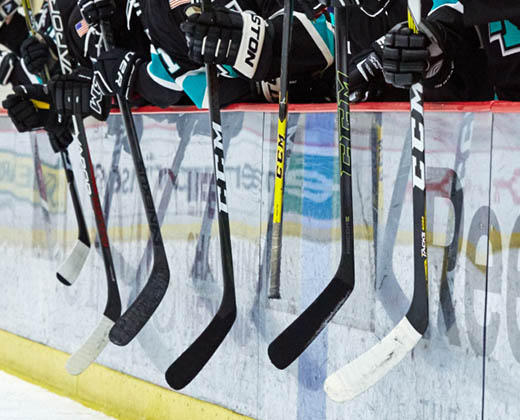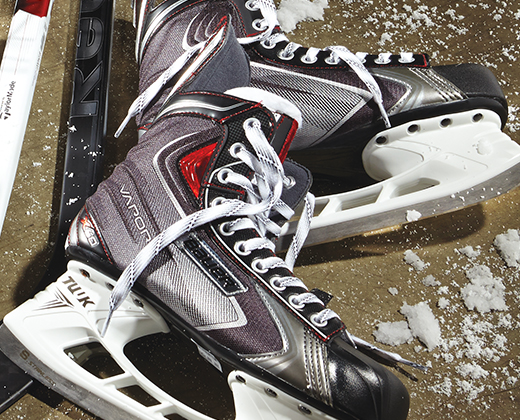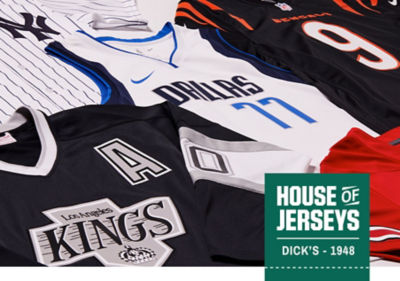Choosing Your Child's First Hockey Stick
Find their first hockey stick with this how-to guide.

Youth hockey sticks come in so many shapes, sizes and materials, and choosing the right one for your child as they take the ice for the first time can be a bit overwhelming.
Fortunately, for boys and girls who begin playing the sport from ages 5-10 (the Mite and Squirt levels) there is a method for finding the stick that is best for them. Here are a few key points for parents and coaches to know before they make their selection:
MEASURE UP
When choosing a stick, finding the proper length is the top priority. If the stick is too long or too short, your child may develop poor skating posture and balance issues that can lead to bad habits on the ice.
To ensure an ideal fit, have your child wear skates, if possible, and place the end of the blade (the toe) on the ground. The end of the stick (the butt) should come up to his or her chin or slightly below. If your child is not wearing skates, the stick should rest at the tip of their nose. Note that longer sticks can be purchased and cut down to proper size.
As your child matures and develops stronger core muscles and skating skills, they may prefer to use a shorter stick that only reaches the sternum. This can result in better puck handling in tight situations against defenders and a quicker shot on net.
STRAIGHTEN THOSE CURVES
Generally, parents of younger players should be less concerned with advanced stick features like flex ratings (how much the shaft bends), lies (the angle of the blade from the shaft), blade shapes (round vs. squared) or curves (open vs. closed). These will come into play later as a player hones his or her skills and tailors their equipment to suit their games.
However, if you choose to buy a stick with a blade curvature, the curve's maximum depth should be minimal: no more than one-half inch. This is determined by laying the stick flat with the blade curve facing down on the surface, forming an arch. Measure from the point of maximum curve (between the blade heel and toe) to the ground to calculate the amount of depth.
The face (or front) of the blade should also be as closed (or perpendicular to the ice) as possible, rather than open. An open style is determined by looking down and seeing how much of the blade face is visible. The more you see, the more open it is. By keeping the blade closed, children can have greater success when receiving passes (especially on the backhand side), develop better stick handling skills and have more accuracy when shooting the puck. When novice players use big blade curves, their shots tend to sail up and over the net.
IT'S A MATERIAL WORLD
Today's sticks come in one-piece or two-piece designs and run the gamut from tried-and-true wood to high-tech carbon fiber or graphite composites. For parents of boys and girls who are new to the sport, it's important to note that having two sticks available for your child at every game is recommended.
Wood models are more durable, although they are slightly heavier than their non-wood counterparts. Conversely, carbon fiber and graphite composite models are easier for little ones to skate with over long periods of time. Costs vary (wood is generally more economical) but parents should anticipate replacing sticks each season as their children continue to grow.
WATCH THAT BLADE
After moderate use, take a look at the bottom of the blade where it makes contact with the ice. If it looks worn down or frayed near the heel, it could be an indicator that the stick is too long or that the child has poor balance and is using the blade as a means of support.
When shooting the puck, the key is to have as much of the blade lay flush with the ice surface as possible on contact. This results in the maximum amount of velocity and energy on the shot, which is important, since children competing at the youngest levels of play are usually limited to wrist shots. Winding up on slap shots at the Mite and Squirt levels is prohibited.
Overall, purchasing a first hockey stick means making sure that whatever model you choose for your budding superstar, it fits them perfectly. This will build their confidence while affording them the best chance for success and enjoyment on the ice for years to come.








